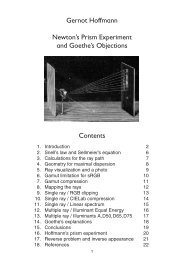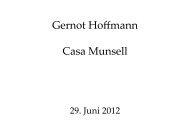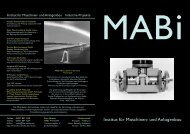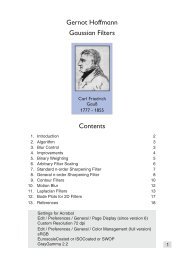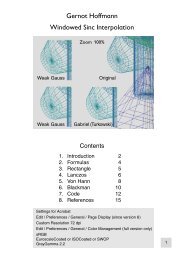Gernot Hoffmann Application of Quaternions
Gernot Hoffmann Application of Quaternions
Gernot Hoffmann Application of Quaternions
You also want an ePaper? Increase the reach of your titles
YUMPU automatically turns print PDFs into web optimized ePapers that Google loves.
<strong>Gernot</strong> <strong>H<strong>of</strong>fmann</strong><br />
<strong>Application</strong> <strong>of</strong> <strong>Quaternions</strong><br />
The original report<br />
Anleitung zum praktischen Gebrauch von Quaternionen<br />
was written in February 1978<br />
for Pr<strong>of</strong>.Dr.J.Baumgarte<br />
Technische Universität Braunschweig<br />
Actual translation<br />
Composition by PageMaker<br />
No significant modifications<br />
Old pencil drawings<br />
January 20/2002<br />
Appendices contain newer information<br />
The practical application <strong>of</strong> quaternions<br />
is shown in Appendix A<br />
November 02/2002<br />
May 21/2005<br />
August 17/2005<br />
Website<br />
Please load browser and click here<br />
1
<strong>Application</strong> <strong>of</strong> <strong>Quaternions</strong><br />
Contents<br />
1. Definition and Features 3<br />
2. Rotational Transformations 5<br />
3. Transformation <strong>of</strong> Angular Velocities 7<br />
4. Rotational Equation <strong>of</strong> Motion in Euler Formulation 11<br />
4.1 Rotational Euler Equation by <strong>Quaternions</strong><br />
4.2 Transformation <strong>of</strong> Torques<br />
5. Rotational Equation <strong>of</strong> Motion in Lagrange Formulation 14<br />
5.1 Rotational Lagrange Equation by <strong>Quaternions</strong><br />
5.2 Transformation <strong>of</strong> Torques<br />
6. Transformations for Classical Euler Angles 16<br />
6.1 Rotational Transformations<br />
6.2 Transformations by <strong>Quaternions</strong><br />
6.3 Calculation <strong>of</strong> Angles<br />
7. Transformations for Aircraft Angles 18<br />
7.1 Rotational Transformations<br />
7.2 Transformations by <strong>Quaternions</strong><br />
7.3 Calculation <strong>of</strong> Angles<br />
8. References 20<br />
8.1 Original References<br />
8.2 References quoted from [1]<br />
9. Appendix A Rigid Body Rotation Half-Quat 21<br />
10. Appendix B Rigid Body Rotation Full-Quat 32<br />
11. Appendix C Spherical Linear Interpolation 37<br />
2
1. Definition and Features<br />
<strong>Quaternions</strong> are quadrupels <strong>of</strong> real numbers, for which a special multiplication is defined.<br />
(1.1) Q =<br />
The rules for the multiplication are easily understood if we represent the quaternions by three complex<br />
base vectors i, j, k. Then we have<br />
(1.2) Q = q 1 i + q 2 j + q 3 k +q 4 .<br />
The first three components can be written as a vector or column matrix q :<br />
(1.3) Q = q + q 4<br />
This scheme is valid for the multiplication, e.g. j·k = i :<br />
(1.4)<br />
q 1<br />
q 2<br />
q 3<br />
q 4<br />
Now we can already execute the multiplication <strong>of</strong> two quaternions Q and S. Opposed to matrix<br />
multiplications, we use always the dot.<br />
(1.5) P = Q·S<br />
(1.6) Q·S= (q 1 i + q 2 j + q 3 k + q 4 )·(s 1 i + s 2 j + s 3 k + s 4 ) = p 1 i + p 2 j + p 3 k + p 4 = p + p 4<br />
p1 q4 - q3 q2 q1 s1 p2 q3 q4 - q1 q2 s<br />
(1.7) =<br />
2<br />
p3 - q2 q1 q4 q3 s3 p4 - q1 - q2 - q3 q4 s4 The result <strong>of</strong> the multiplication is the product <strong>of</strong> the quaternion matrix R(Q) , which is assigned to Q,<br />
and the quaternion S, written as column matrix:<br />
(1.8) P = R(Q) S<br />
i j k<br />
i -1 k -j<br />
j -k - 1 i<br />
k j - i -1<br />
In [3] it is shown, that the multiplication can be executed by using normal, dot and cross products:<br />
(1.9) P = p + p 4 =(q 4 s 4 - q T s) + (q 4 s + s 4 q + q × s)<br />
It is q T s the dot product and q × s the cross product <strong>of</strong> the vector part <strong>of</strong> the quaternions.<br />
3
Each quaternion has a conjugate quaternion Q' :<br />
(1.10) Q' =<br />
- q 1<br />
- q 2<br />
- q 3<br />
+ q 4<br />
The multiplication is not commutative but associative:<br />
(1.11) Q 1 ·Q 2 ≠ Q 2 ·Q 1<br />
Q 1 ·Q 2 ≠ - Q 2 ·Q 1<br />
Q 1 ·(Q 2 ·Q 3 ) = (Q 1 ·Q 2 )·Q 3<br />
The following rule can be derived from Eq.(1.9) :<br />
(1.12) (Q·S)'= S'·Q'<br />
(1.13) S'·Q' = (q 4 s 4 - (-s) T (-q)) + (q 4 (-s) + s 4 (-q) + (-s)×(-q))<br />
=(q 4 s 4 - q T s) - (q 4 s + s 4 q + q×s) =(S·Q)'<br />
The norm <strong>of</strong> a quaternion is one or has to be made to one:<br />
(1.14) Q·Q' = q 1 2 + q2 2 + q3 2 + q4 2 = 1<br />
For Q = Q(t) we have<br />
· ·<br />
(1.15) Q·Q' + Q·Q' = 0 .<br />
Definition and Features<br />
William Rowan Hamilton (1805 - 1865) had invented the quaternions.<br />
Arthur Cayley (1821 - 1895) and Felix Klein (1849 - 1925) had contributed further.<br />
4
2. Rotational Transformations<br />
We consider quaternions with this structure and want to execute coordinate system rotations:<br />
(2.1) Q = cos(α/2) - n sin(α/2)<br />
The same physical vector x has the column matrix x 1 in coordinate system 1 and x 2 in system 2.<br />
System 2 is rotated relative to system 1 by a right screw rotation about n with the angle α .<br />
Then we have these transformations for the column matrices:<br />
(2.2) x 2 = Q·x 1 ·Q'<br />
(2.3) x 1 = Q'·x 2 ·Q<br />
We can verify this rule by an example.<br />
Rotate by α about the axis z 1 .<br />
Note: the rotation axis vector n has the same column matrices n 1 = n 2 in both coordinate systems.<br />
For the special case we assign k to n and get:<br />
(2.4) Q = cos(α/2) - k sin(α/2)<br />
(2.5) Q' = cos(α/2) + k sin(α/2)<br />
(2.6) x 2 = ( cos(α/2) - k sin(α/2) )·(x 1 i + y 1 j + z 1 k)·( cos(α/2) + k sin(α/2) )<br />
x1 [ cos2 (α/2) - sin2 (α/2)] + 2y1 [ sin(α/2)cos(α/2) ]<br />
(2.7) x2 = -2x1 [ sin(α/2)cos(α/2) ] + y1 [cos2 (α/2) - sin2 (α/2)]<br />
cos(α) sin (α) 0<br />
(2.8) x2 = - sin (α) cos(α) 0 x1 0 0 1<br />
This is the well known rotation matrix for the coordinate<br />
transformation <strong>of</strong> a fixed vector.<br />
Note: the fourth component in the quaternion product<br />
Q·x·Q' is always zero.<br />
Several sequential rotations about arbitrary axes are<br />
described by sequential quaternion products:<br />
x 2 = Q 1 · x 1 ·Q 1 '<br />
(2.9) x 3 = Q 2 ·x 2 ·Q 2 '<br />
x4 = Q 3 ·x 3 ·Q 3 '<br />
(2.10) x 4 = Q 3 ·Q 2 ·Q 1 ·x 1 ·Q 1 '·Q 2 '·Q 3 ' =<br />
z 1<br />
Q·x 1 ·Q'<br />
5
Rotational Transformations<br />
In each quaternion Q the components q1,q2,q3 and q4 depend on the type and sequence <strong>of</strong> rotation<br />
angles, which are called Euler angles or Cardan angles.<br />
But it is possible to express the left-right quaternion product for all cases by one matrix multiplication:<br />
(2.11) x 4 = C 41 x 1<br />
The so-called Cayley matrix C 41 is calculated straightforward.<br />
q 1 2 -q2 2 -q3 2 +q4 2 2(q 1 q 2 -q 3 q 4 ) 2(q 1 q 3 +q 2 q 4 )<br />
(2.12) C 41 = 2(q 1 q 2 +q 3 q 4 ) -q 1 2 +q2 2 -q3 2 +q4 2 2(-q 1 q 4 +q 2 q 3 )<br />
2(q 1 q 3 -q 2 q 4 ) 2(q 1 q 4 +q 2 q 3 ) -q 1 2 -q2 2 +q3 2 +q4 2<br />
Opposed to coordinate system rotations, a body rotation uses this equation:<br />
(2.13) Q = cos(α/2) + n sin(α/2) .<br />
This can be easily explained by replacing the angle by the negative angle.<br />
The quaternion coordinate system rotation can be alternatively defined by this formulation:<br />
(2.14) Q = cos(α/2) + n sin(α/2)<br />
Then all transformations have to be written in this order:<br />
( 2.15) x 2 = Q'·x 1 ·Q<br />
The Cayley matrix has to be substituted by the transposed.<br />
6
3. Transformation <strong>of</strong> Angular Velocities<br />
The coordinate system 4 rotates relative to system 1 with the angular velocity ω 14 . This physical vector<br />
is described as a column matrix ω 4 14 in system 4 . The vector, which is fixed in 1, has then a time<br />
variable component in 4 . Euler´s formula delivers for this coordinate transformation :<br />
·<br />
(3.1) x 4 = -ω 4 14 × x4<br />
Now we show by an example that the sign is correct.<br />
·<br />
(3.2) ω 4 12 = ( 0 , 0 , α ) T<br />
(3.3) x 2 = ( x 2 , y 2 , 0 ) T<br />
· · · · · ·<br />
(3.4) x 2 = ( x 2 , y 2 , z 2 ) T = ( y 2 α , - x 2 α , 0 ) T<br />
It can be seen in the drawing, that indeed x 2 increases<br />
and y 2 decreases.<br />
Now we look for a similar relation for quaternions, based on the coordinate transformation<br />
(3.5) x 4 = Q·x 1 ·Q'.<br />
For a constant x 1 we find the derivative<br />
· · ·<br />
(3.6) x 4 = Q·x 1 ·Q' + Q ·x 1 ·Q'<br />
Because <strong>of</strong><br />
(3.7) x 1 = Q'·x 4 ·Q<br />
and with Q·Q' = 1 we find<br />
· · ·<br />
(3.8) x 4 = Q·Q'·x 4 ·Q·Q' + Q·Q'·x 4 ·Q·Q' ,<br />
· · ·<br />
(3.9) x 4 = Q·Q'·x 4 + x 4 ·Q·Q' .<br />
By differentiation <strong>of</strong> the norm<br />
· ·<br />
(3.10) 0 = Q·Q' + Q·Q'<br />
we get<br />
· · ·<br />
(3.11) x 4 = Q·Q'·x 4 - x 4 ·Q·Q' .<br />
Now we omit for clarity the index for the coordinate system and write simply<br />
·<br />
(3.12) T = Q·Q' = t + t 4 .<br />
7
Using Eq.(1.9) we find<br />
(3.13) T·x = t T x + t 4 x + t × x ,<br />
(3.14) - x·T = - t T x - t 4 x - x× t ,<br />
·<br />
(3.15) x = 2t × x .<br />
By comparison with Eq.(3.1) we see<br />
(3.16) ω = - 2t .<br />
Transformation <strong>of</strong> Angular Velocities<br />
Now we add a fourth component and build a quaternion<br />
(3.17) ω = ω ω + + ω4 = - 2T = - 2 Q ·Q' .<br />
Now we use again Eq.(3.10)<br />
· ·<br />
(3.18) Q·Q' = - Q·Q'<br />
and because <strong>of</strong> Eq.(1.15) we have<br />
· ·<br />
(3.19) (Q·Q')' = Q·Q' .<br />
Therefore this is also valid:<br />
· ·<br />
(3.20) (Q·Q')' = - Q·Q'<br />
(3.21) T = - T'<br />
This means, that the fourth component t 4 = ω 4 /2 is always zero.<br />
So far we have the intermediate result<br />
· ·<br />
(3.22) ω ω + + ω4 = - 2 Q ·Q' = 2Q·Q' ,<br />
which should be shown as a matrix multiplication <strong>of</strong> this type:<br />
(3.23) ω ω + + ω4 = W(Q) Q<br />
·<br />
· ·<br />
In Eq.(3.22) we have 2Q·Q' , but we want to express the angular velocity in Q .<br />
Therefore we apply the matrix multiplication Eq.(1.9) explicitely (next page).<br />
8
(3.24)<br />
Transformation <strong>of</strong> Angular Velocities<br />
·<br />
- q 1<br />
· ·<br />
R(Q) Q' - q2 ·<br />
- q3 ·<br />
q4 q4 - q3 q2 q1 · · · ·<br />
- q4q1 +q3q2 -q2q3 +q1q4 q3 q4 - q1 q2 · · · ·<br />
- q3q1 -q4q2 +q1q3 +q2q4 - q2 q1 q4 q3 · · · ·<br />
q2q1 - q1q2 -q4q3 +q3q4 - q1 - q2 - q3 q4 · · · ·<br />
q1q1 +q2q2 +q3q3 +q4q4 Then we find, using a new matrix V :<br />
· ·<br />
(3.25) ω = W(Q) Q = 2 V(Q) Q<br />
(3.26) V =<br />
- q 4 q 3 - q 2 q 1<br />
- q 3 - q 4 q 1 q 2<br />
q 2 - q 1 - q 4 q 3<br />
q 1 q 2 q 3 q 4<br />
V T =<br />
·<br />
Because <strong>of</strong> ω4 = 2 Σ qiqi = d/dt Q·Q' we find ω4 = 0.<br />
It can be easily shown for normalized quaternions: V V T = I .<br />
V is orthogonal (orthonormal) and we have furtheron<br />
(3.27) V -1 = V T ,<br />
(3.28) W -1 = (1/2)V T = (1/4)W T .<br />
The inverse exists for all q i .<br />
- q 4 - q 3 q 2 q 1<br />
q 3 - q 4 - q 1 q 2<br />
- q 2 q 1 - q 4 q 3<br />
q 1 q 2 q 3 q 4<br />
Note:<br />
Somewhere one may find V(Q) replaced by V T (Q) . This is a result <strong>of</strong> a different definition <strong>of</strong> the<br />
quaternion coordinate rotation by Eq.(2.14) .<br />
This should not be confused with body rotations. In our preferred formulation, a body rotation looks<br />
also like Eq.(2.14), but in fact it is the conjugate <strong>of</strong> Eq.(2.1)<br />
(3.29) Q = cos(α/2) + n sin(α/2) .<br />
9
Transformation <strong>of</strong> Angular Velocities<br />
An example shows that Eq.(3.25) is correct. Again we rotate by α about the z-axis.<br />
(3.30) Q = cos(α/2) - k sin(α/2) = =<br />
0<br />
0<br />
- sin (α/2)<br />
q4 cos(α/2)<br />
- cos(α/2) - sin(α/2) 0 0 0<br />
(3.31) ω = 2<br />
sin (α/2)<br />
0<br />
0<br />
- cos(α/2)<br />
0<br />
0<br />
0<br />
- cos(α/2)<br />
- sin(α/2)<br />
0<br />
- sin(α/2)<br />
cos(α/2)<br />
0<br />
·<br />
- (α/2) cos(α/2)<br />
·<br />
- (α/2) sin (α/2)<br />
(3.32) ω = ( 0 , 0 , α , 0 ) T<br />
·<br />
Further features <strong>of</strong> the matrix V (we write the quaternion as a transposed column):<br />
(3.33) V(Q)Q = ( 0 , 0 , 0, 1 ) T<br />
· ·<br />
(3.34) 0 = V Q + V Q<br />
· ·<br />
(3.35) V Q= - V Q<br />
q1 q2 q3 · · · ·<br />
(3.36) V(Q)Q = V(Q) Q = V(P) P = ( 0 , 0 , 0, 1) T<br />
10
4. Rotational Equation <strong>of</strong> Motion in Euler Formulation<br />
4.1 Rotational Euler Equations by <strong>Quaternions</strong><br />
We consider the rotation <strong>of</strong> a rigid body with the body fixed coordinate system x B = x 4 relative to an<br />
inertial system x I = x 1 . Now we need an observer system x o in which all physical vectors are written as<br />
column matrices. The lower index indicates always the observer system.<br />
The Euler formulation for the angular momentum in rotating observer coordinates:<br />
·<br />
(4.1) L IB<br />
o + ωoIO × LoIB = MoB ω IB Vector <strong>of</strong> the angular velocity <strong>of</strong> the body relative to the inertial system,<br />
ω IO Vector <strong>of</strong> the angular velocity <strong>of</strong> the observer relative to the inertial system<br />
L IB Angular momentum<br />
J Tensor <strong>of</strong> inertia (a 3x3 matrix)<br />
M B Torque<br />
(4.2) L IB = J ω IB<br />
In most cases the observer system is either the inertial system or it is body fixed. We use the body fixed<br />
system and replace therefore in all equations o by B .<br />
This is especially useful to avoid a time variable tensor <strong>of</strong> inertia. Furtheron, many torques can be<br />
expressed easier in body fixed coordinates, e.g. for an aircraft.<br />
·<br />
(4.3) L IB<br />
B + ωBIB ×LBIB = MBB In the next step we extend all column matrices to four dimensions, though this has mostly no physical<br />
meaning. We write the new elements not bold.<br />
L IB<br />
B ω ω IO<br />
B M B<br />
B<br />
(4.4) L = ω = M =<br />
L 4 ω 4 M 4<br />
J B 0<br />
(4.5) J = with J 4 > 0<br />
0 T J 4<br />
Cross products are written as matrix products, e.g. for N = ω ω × L in the new nomenclature:<br />
(4.6) N = ω × L ⇒ N = Ω L<br />
0 - ω z ω y<br />
ω z 0 - ω x 0<br />
(4.7) Ω = - ω y ω x 0<br />
(4.8) N =<br />
ω y L z - ω z L y<br />
ω z L x - ω x L z<br />
ω x L y - ω y L x<br />
0 4 L 4<br />
0 T 0 4<br />
Because <strong>of</strong> ω 4 = 0 in Eq.(3.21) we have L 4 = 0, therefore I 4 and 0 4 are so far not relevant.<br />
11
Rotational Equation <strong>of</strong> Motion in Euler Formulation<br />
With Eq.(3.25) the equation for the angular momentum, Eq.(4.3), is already in quaternion formulation:<br />
(4.9) 2 d/dt (JVQ) + 2 ΩJ VQ = M(Q,Q,t)<br />
(4.10) JVQ + JVQ + ΩJVQ = (1/2) M(Q,Q,t)<br />
According to Eq.(3.36) the term VQ is zero. The inertia term (JV) is never singular, if the extended<br />
tensor <strong>of</strong> inertia is positive definite. Especially no moment <strong>of</strong> inertia on the main diagonal should be<br />
zero. V itself is orthogonal, therefore all inverse operators exist:<br />
(4.11) ( J V) -1 =V -1 J -1 = V T J -1<br />
Multiplying the equation from the left side results in<br />
(4.12) Q + V T J -1 ΩJ VQ = (1/2) V T J -1 M .<br />
Later it will be shown that Ω can be expressed by<br />
(4.13) Ω =2VV T = 2V V T (Q) ,<br />
and we do not need the less elegant conversion ω ⇒ Ω.<br />
Now we write the differential equation as a first order system:<br />
(4.14) Q = P<br />
(4.15) P = - 2 V T J -1 V V T (P)JVP + (1/2)V T J -1 M(Q,P,t)<br />
As long as Ω is not substituted we use<br />
(4.16) ω = 2VP<br />
· ·<br />
· · ·· · ·<br />
·· ·<br />
·<br />
·<br />
· ·<br />
for building Ω in each step <strong>of</strong> a numerical solution.<br />
The reverse transformation from quaternions to physical angles is here not yet possible, because this<br />
depends on the specific sequence <strong>of</strong> Euler or Cardan angles (chapters 6 and 7).<br />
A physical torque can be applied as a general function M(Q,P,t) in body fixed coordinates, in inertial<br />
coordinates or in a mechanical gimbal system in gimbal coordinates. Finally we need the torque in body<br />
fixed coordinates.<br />
(4.17) M B = S BA (Q) M A (Q,P,t)<br />
· ·<br />
4.2 Transformation <strong>of</strong> Torques<br />
·<br />
In this formulation, S BA (Q) is a placeholder for the transformation from an arbitrary source coordinate<br />
system, where the torque can be easily described. A=B is the body fixed system, A=1=I is the inertial<br />
system. A=3 is the last gimbal <strong>of</strong> three .<br />
12
Rotational Equation <strong>of</strong> Motion in Euler Formulation<br />
For the moment, we refer to a physical torque M = M(ω,α,α,t). Is it possible under all circumstances to<br />
replace the physical variables by quaternions ?<br />
The angles can be replaced if we use a specific set <strong>of</strong> Euler or Cardan Angles., e.g. Eq.(6.18).<br />
The angular velocity is easily replaced by<br />
(4.18) ω = 2V(Q)Q .<br />
Again we refer to physical variables, e.g. Eq.(6.16):<br />
(4.19) ω = B(α) α<br />
α<br />
The matrix B becomes singular in one orientation, for the classical Euler angles for θ=0.<br />
It´s well known, that a set <strong>of</strong> physical angles can cause the so called gimbal lock.<br />
Then Eq.(4.19) cannot be inverted:<br />
·<br />
(4.20) α = B -1 ω<br />
Is it possible to cure the problem by quaternions ?<br />
The figure shows a free-running gyro in gimbals. For example, we have some friction in gimbal bearings,<br />
·<br />
which may be modelled by a function M(α). Therefore we have to calculate these torques by explicite<br />
·<br />
use <strong>of</strong> α α . <strong>Quaternions</strong> don´t cure the problem for systems with mechanical gimbals.<br />
In the gimbal lock orientation θ= 0 we find by use <strong>of</strong> Eq.(6.16):<br />
ωx 0 cos(ψ) 0 φ<br />
·<br />
(4.21) ωy = 0 - sin (ψ) 0 θ<br />
·<br />
ωz 1 0 1 ψ<br />
·<br />
·<br />
It is not possible to express ω z uniquely by φ and ψ .<br />
·<br />
· ·<br />
For the gyro in gimbals, the problem can be solved by equations <strong>of</strong> motions for the flywheel and all<br />
gimbals as well. Instead three differential equations <strong>of</strong> second order we have then nine equations.<br />
This gyro is <strong>of</strong> course not a reasonable practical design. E.g. for an artificial horizon one would not use<br />
the classical Euler angles, but Cardan angles, where the gimbals are orthogonal in normal<br />
position. Then, an aircraft would have gimbal lock in a vertical climb.<br />
13<br />
·
5. Rotational Equation <strong>of</strong> Motion in Lagrange Formulation<br />
5.1 Rotational Lagrange Equation by <strong>Quaternions</strong><br />
The rotational part <strong>of</strong> the kinetic energy is a quadratic form:<br />
(5.1) T = (1/2)ω T J ω<br />
The angular velocity is ω= ω IB and the tensor <strong>of</strong> inertia J is constant in body fixed coordinates.<br />
Using Eq.(3.25) and Eq.(3.35) the energy can be expressed in quaternions:<br />
(5.2) T = 2 Q T V T JVQ<br />
(5.3) T = 2 Q T V T JVQ<br />
Lagrange equations:<br />
d ∂ T ∂ T<br />
(5.7) –– ––– · – ––– = ML dt ∂Q ∂Q<br />
The physical meaning <strong>of</strong> M L is not yet clear. If Q is a set <strong>of</strong> generalized coordinates then M L should be<br />
the generalized torque. A quadratic form is derived like this:<br />
(5.5) –– xT d<br />
Ax = 2 Ax<br />
dx<br />
Now we derive the parts <strong>of</strong> the Lagrange equation:<br />
∂ T<br />
·<br />
∂Q<br />
d ∂ T<br />
·<br />
dt ∂Q<br />
∂ T<br />
∂Q<br />
· ·<br />
(5.6) ––– = 4VTJVQ = 2 VT ·<br />
Jω<br />
(5.7) –– ––– = 2V T Jω + 2V T Jω<br />
(5.8) ––– = 4VTJV Q = - 2VT · · ·<br />
Jω<br />
Assembled, and using VQ = 0 for the first three components:<br />
(5.9) 2V T Jω + 2V T Jω + 2V T Jω = M L<br />
(5.10) ω = 2VQ + 2VQ<br />
· ·<br />
· · ·<br />
· · · · ·<br />
(5.11) 4V T JVQ + 8V T JVQ = M L<br />
· ·<br />
· ·<br />
· ·<br />
· · · ·<br />
· ·<br />
(5.12) JVQ + 2VV T JVQ = (1/4) VM L<br />
The Lagrange Equation can be written as as a first order system. The inverse <strong>of</strong> the tensor <strong>of</strong> inertia<br />
exists.<br />
14
Rotational Equation <strong>of</strong> Motion in Lagrange Formulation<br />
Now we write the differential equation as a first order system:<br />
(5.13) Q = P<br />
·<br />
·<br />
(5.14) P = - 2V T J -1 VV T JVP + (1/4) V T J -1 VM L<br />
The reverse transformation from quaternions to physical angles is here not yet possible, because it<br />
depends on the specific sequence <strong>of</strong> Euler or Cardan angles (chapters 6 and 7).<br />
5.1 Transformation <strong>of</strong> Torques<br />
Eq.(5.12) is the same as Eq.(4.10). By comparison we find:<br />
(5.15) Ω = 2VV T<br />
(5.16) M = (1/2)VM L<br />
The last equation shows the relation between the body fixed torque M and the torque in the Lagrange<br />
equation M L .<br />
(5.17) M L = 2V T M<br />
This is, ignoring the factor 4, equivalent to the transformation <strong>of</strong> angular velocities:<br />
·<br />
·<br />
(5.18) Q = (1/2)V Tω<br />
·<br />
·<br />
15
6. Transformations for Classical Euler Angles<br />
6.1 Rotational Transformations<br />
Rotation about z 1 with φ :<br />
(6.1) x 2 = T 21 x 1<br />
cos(φ) sin (φ) 0<br />
(6.2) T 21 = - sin(φ) cos(φ) 0<br />
0 0 1<br />
(6.3) Q 1 = cos(φ/2) - k sin(φ/2)<br />
Rotation about x 2 with θ :<br />
(6.4) x 3 = T 32 x 2<br />
1 0 0<br />
(6.5) T 32 = 0 cos(θ) sin (θ)<br />
0 - sin (θ) cos(θ)<br />
(6.6) Q 2 = cos(θ/2) - i sin(θ/2)<br />
Rotation about z 3 with ψ :<br />
(6.7) x 4 = T 43 x 3<br />
cos(ψ) sin (ψ) 0<br />
(6.8) T 43 = - sin(ψ) cos(ψ) 0<br />
0 0 1<br />
(6.9) Q 3 = cos(ψ/2) - k sin(ψ/2)<br />
Three angle rotation:<br />
(6.10) x 4 = T 41 x 1<br />
(6.11) T 41 = T 43 T 32 T 21<br />
cos(ψ) sin (ψ) cos(θ) sin (ψ) sin (θ)<br />
(6.12) T 42 = - sin(ψ) - cos(ψ) sin (θ) cos(ψ) sin (θ)<br />
0 - sin (θ) cos(θ)<br />
cos(ψ) cos(φ) cos(ψ) sin (φ) sin(ψ) sin (θ)<br />
(6.13) T41 =<br />
- sin (ψ) cos(θ) sin (φ) + sin (ψ) cos(θ) cos(φ)<br />
- sin(ψ) cos(φ) - sin (ψ) sin (φ)<br />
- cos(ψ) cos(θ) sin (φ) + cos(ψ) cos(θ) cos(φ)<br />
cos(ψ) sin (θ)<br />
sin (θ) sin (φ) - sin (θ) cos(φ) cos(θ)<br />
Reverse transformation:<br />
(6.14) x 1 = T 41 -1 x4 = T 41 T x4<br />
16
6.2 Transformation <strong>of</strong> Angular Velocities<br />
The angular velocities about Euler axes must be transformed by appropriate rotation matrices into the<br />
body fixed system.<br />
0 θ 0<br />
(6.15) ω 14<br />
4 = T43T32 0 + T<br />
· 43<br />
φ<br />
0 + 0<br />
·<br />
0 ψ<br />
sin (θ) sin (ψ) cos(ψ) 0 φ<br />
(6.16) ω 14<br />
·<br />
4 = sin (θ) cos(ψ) - sin(ψ) 0 θ<br />
·<br />
cos(θ) 0 1 ψ<br />
(6.17) ω 4 14 = B (φ, θ, ψ) T = B α<br />
A singularity happens for Det(B) = - sin(θ) = 0 , especially for θ = 0° .<br />
q1 0<br />
(6.18)<br />
q2 0<br />
= Q<br />
q3 3 ·Q2 ·Q1 = R(Q3 ) R(Q2 )Q1 - sin (φ/2)<br />
q4 cos(φ/2)<br />
cos(θ/2) 0 0 - sin(θ/2) - sin(θ/2) cos(φ/2)<br />
0 cos(θ/2) sin(θ/2) 0 - sin(θ/2) sin (φ/2)<br />
0 - sin(θ/2) cos(θ/2) 0 - cos(θ/2) sin (φ/2)<br />
sin(θ/2) 0 0 cos(θ/2) cos(θ/2) cos(φ/2)<br />
cos(ψ/2) sin (ψ/2) 0 0 - cos(ψ/2) sin(θ/2) cos(φ/2) - sin (ψ/2) sin(θ/2) sin (φ/2)<br />
- sin (ψ/2) cos(ψ/2) 0 0 sin (ψ/2) sin (θ/2) cos(φ/2) - cos(ψ/2) sin(θ/2) sin (φ/2)<br />
0 0 cos(ψ/2) -sin (ψ/2) - cos(ψ/2) cos(θ/2) sin (φ/2) - sin (ψ/2) cos(θ/2) cos(φ/2)<br />
0 0 sin (ψ/2) cos(ψ/2) sin (ψ/2) cos(θ/2) sin (φ/2) +cos(ψ/2) cos(θ/2) cos(φ/2)<br />
The Euler angles for a quaternion are found by comparing the Cayley matrix Eq.(2.12) and the Euler<br />
matrix Eq. (6.13).<br />
(6.19) x 4 = T 41 x 1 = C 41 x 1<br />
(6.20) c 13 = sin(ψ)sin(θ)<br />
c 23 = cos(ψ)sin (θ)<br />
c 31 = sin(θ) sin (φ)<br />
c 32 = - sin (θ) cos(φ)<br />
c 33 = cos(θ)<br />
(6.21) tan(ψ) = c 13 /c 23<br />
tan(φ) = -c 31 /c 32<br />
tan(θ) = sqrt(c 13 2 + c23 2 )/c33<br />
Transformations for Classical Euler Angles<br />
· · · ·<br />
6.3 Transformations by <strong>Quaternions</strong><br />
6.4 Calculation <strong>of</strong> Angles<br />
·<br />
A four quadrant function z(y,x) = arctan(y/x) is necessary. Singularity 0/0 for θ = 0 .<br />
·<br />
17
Rotation about z 1 with ψ :<br />
(7.1) x 2 = T 21 x 1<br />
7. Transformations for Aircraft Angles<br />
7.1 Rotational Transformations<br />
cos(ψ) sin (ψ) 0<br />
(7.2) T 21 = - sin(ψ) cos(ψ) 0<br />
0 0 1<br />
(7.3) Q 1 = cos(φ/2) - k sin(φ/2)<br />
Rotation about y 2 with θ :<br />
(7.4) x 3 = T 32 x 2<br />
cos(θ) 0 - sin(θ)<br />
(7.5) T 32 = 0 1 0<br />
sin (θ) 0 cos(θ)<br />
(7.6) Q 2 = cos(θ/2) - j sin(θ/2)<br />
Rotation about x 3 with φ :<br />
(7.7) x 4 = T 43 x 3<br />
1 0 0<br />
(7.8) T43 = 0<br />
0<br />
cos(φ)<br />
- sin (φ)<br />
sin (φ)<br />
cos(φ)<br />
(7.9) Q 3 = cos(ψ/2) - i sin(ψ/2)<br />
Three angle rotation:<br />
(7.10) x 4 = T 41 x 1<br />
(7.11) T 41 = T 43 T 32 T 21<br />
cos(θ) 0 - sin(θ)<br />
(7.12) T 42 = sin (θ) sin (φ) cos(φ) cos(θ) sin (φ)<br />
sin (θ) cos(φ) - sin (φ) cos(θ) cos(φ)<br />
(7.13) T 41 =<br />
Reverse transformation:<br />
(7.14) x 1 = T 41 -1 x4 = T 41 T x4<br />
cos(ψ) cos(θ) sin (ψ)cos(θ) - sin (θ)<br />
- sin (ψ) cos(φ) cos(ψ) cos(φ) cos(θ) sin (φ)<br />
+cos(ψ) sin (θ) sin (φ) + sin (ψ) sin (θ) sin (φ)<br />
sin (ψ) sin (φ) - cos(ψ) sin (φ) cos(θ) cos(φ)<br />
cos(ψ) sin (θ) cos(φ) + sin (ψ) sin (θ) cos(φ)<br />
18
7.2 Transformation <strong>of</strong> Angular Velocities<br />
The angular velocities about Euler axes must be transformed by appropriate rotation matrices into the<br />
body fixed system.<br />
0 0 φ<br />
(7.15) ω 14<br />
·<br />
4 = T43T32 0 + T43 θ + 0<br />
·<br />
ψ 0 0<br />
- sin (θ) 0 1 ψ<br />
(7.16) ω 14<br />
·<br />
4 = sin (φ) cos(θ) cos(φ) 0 θ<br />
·<br />
cos(φ) cos(θ) - sin(φ) 1 φ<br />
(7.17) ω 4 14 = B (ψ,θ, φ) T = B α<br />
A singularity happens for Det(B) = - cos(θ) = 0 , especially for θ = 90° .<br />
q1 0<br />
(7.18)<br />
q2 0<br />
= Q<br />
q3 3 ·Q2 ·Q1 = R(Q3 ) R(Q2 )Q1 - sin (ψ/2)<br />
q4 cos(ψ/2)<br />
cos(θ/2) 0 - sin(θ/2) 0 sin (ψ/2) sin (θ/2)<br />
0 cos(θ/2) 0 - sin(θ/2) - cos(ψ/2) sin (θ/2)<br />
sin(θ/2) 0 cos(θ/2) 0 - sin (ψ/2) cos(θ/2)<br />
0 sin(θ/2) 0 cos(θ/2) cos(ψ/2) cos(θ/2)<br />
cos(φ/2) 0 0 - sin (φ/2) sin (ψ/2) sin (θ/2) cos(φ/2) - cos(ψ/2) cos(θ/2) sin (φ/2)<br />
0 cos(φ/2) sin (φ/2) 0 - cos(ψ/2) sin (θ/2) cos(φ/2) - sin (ψ/2) cos(θ/2) sin (φ/2)<br />
0 - sin (φ/2) cos(φ/2) 0 cos(ψ/2) sin (θ/2) sin (φ/2) - sin (ψ/2) cos(θ/2) cos(φ/2)<br />
sin (φ/2) 0 0 cos(φ/2) sin (ψ/2) sin(θ/2) sin (φ/2) +cos(ψ/2) cos(θ/2) cos(φ/2)<br />
The Euler angles for a quaternion are found by comparing the Cayley matrix Eq.(2.12) and the Euler<br />
matrix Eq. (7.13).<br />
(7.19) x 4 = T 41 x 1 = C 41 x 1<br />
(7.20) c 11 = cos(ψ) cos(θ)<br />
c 12 = sin(ψ)cos(θ)<br />
c 13 = -sin (θ)<br />
c 23 = cos(θ) sin (φ)<br />
c 33 = cos(θ) cos(φ)<br />
(7.21) tan(ψ) = c 12 /c 11<br />
tan(φ) = c 23 /c 33<br />
tan(θ) =-c 13 / sqrt(c 11 2 + c12 2 )<br />
Transformations for Aircraft Angles<br />
· · · ·<br />
7.3 Transformations by <strong>Quaternions</strong><br />
7.4 Calculation <strong>of</strong> Angles<br />
A four quadrant function z(y,x) = arctan(y/x) is necessary. Singularity 0/0 for θ = 90° .<br />
·<br />
·<br />
19
8.1 Original References<br />
8. References<br />
[1] Steuer, A. Die Beschreibung räumlicher Bewegungen durch Quaternionen<br />
Seminarvortrag am Lehrstuhl für Flugmechanik<br />
TU Braunschweig, 1972<br />
[2] Lohe, R. Die Beschreibung der Bewegungsgleichungen des Kreisels<br />
Seminarvortrag am Lehrstuhl A für Mechanik<br />
TU Braunschweig, 1976<br />
[3] Corben, H.C. Classical Mechanics<br />
Stehle, P. John Wiley & Sons, Inc.<br />
New York, 1957<br />
[4] Vitins, M. Contributions to the descriptions <strong>of</strong> gyros by quaternions.<br />
By courtesy <strong>of</strong> Pr<strong>of</strong>.Dr.J.Baumgarte<br />
[5] Wells, D.A. Lagrangian Dynamics<br />
Schaum´s Outline Series<br />
McGraw-Hill Book Company<br />
New York, 1967<br />
8.2 Some references quoted from [1]<br />
[6] Hamel, G. Theoretische Mechanik<br />
[7] Madelung, E. Die mathematischen Hilfsmittel des Physikers<br />
[8] Kowalewski, G. Lehrbuch der höheren Mathematik<br />
[9] Niemz, W. Anwendung der Quaternionen auf die allgemeinen Bewegungsgleichungen der<br />
Flugmechanik . ZFW 11, 1963, S.368-372<br />
[10] Goldstein, H. Klassische Mechanik<br />
[11] Whittaker, E.T. Treatise on the Analytical Dynamics <strong>of</strong> Particles and Rigid Bodies<br />
[12] Whittaker, E.T Analytical Dynamics<br />
[13] Surber, T.E. On the use <strong>of</strong> quaternions to describe the angular orientation <strong>of</strong> space vehicles<br />
J.Aerospace Sci. 28, 1961<br />
[14] Robinson A.C. On the use <strong>of</strong> quaternions in simulation <strong>of</strong> rigid body motion<br />
WADC TR 58-17, 1958<br />
[15] Blaschke, W. Analytische Geometrie<br />
[16] Sommerfeld,A. Theorie des Kreisels<br />
Klein, F.<br />
20
9.1 Appendix A Rigid Body Rotation Half-Quat<br />
This chapter describes the simulation <strong>of</strong> a<br />
rigid body rotation. The tensor <strong>of</strong> inertia is<br />
always symmetric, but products <strong>of</strong> inertia are<br />
not necessarily zero.<br />
The first differential equation delivers the angular<br />
acceleration as a function <strong>of</strong> angular<br />
velocities and body fixed torques T.<br />
This part is totally independent <strong>of</strong> Euler<br />
angles, as long as the torques are not<br />
expressed as functions <strong>of</strong> angles.<br />
The second differential equation delivers the<br />
quaternion derivative as a function <strong>of</strong> the angular<br />
velocity. Because the angular velocities<br />
are still used, the method is called Half-Quat.<br />
The quaternion representation doesn´t suffer<br />
from gimbal lock.<br />
The physical interface which delivers the<br />
Euler angles has <strong>of</strong> course a singularity at<br />
cos(θ)=0. A simulation without gimbal lock<br />
requires also a graphics program based on<br />
quaternions (page 25).<br />
·<br />
ω = J -1 (-( ω×J ω) + T )<br />
·<br />
Q = (1/2) V T (Q)ω, ω 4 =0<br />
The integration is performed by ’False Euler’.<br />
This means that the results <strong>of</strong> the angular<br />
velocities are immediately used as inputs for<br />
the integration <strong>of</strong> the quaternion. Standard<br />
Euler would use only old values on the right<br />
side.<br />
The quaternion norm is stabilized by a norm<br />
controller. This algorithm is independent <strong>of</strong><br />
the stepsize dT. The whole system is stable<br />
for small dT≤ 0.3 .<br />
For vanishing products <strong>of</strong> inertia the tensor<br />
is diagonal, and the set <strong>of</strong> equations can be<br />
simplified.<br />
·<br />
ω x = (ω y ω z (J y -J z )+T x )/J x<br />
·<br />
ω y = (ω z ω x (J z -J x )+T y )/J y<br />
·<br />
ω z = (ω x ω y (J x -J y )+T z )/J z<br />
·<br />
Q = (1/2) V T (Q)ω<br />
This case is not treated in the code example.<br />
Standard aircraft angles: ψ=15°, θ =30°, φ =15°<br />
Gimbal lock orientation: ψ= 0°, θ =90°, φ =0°<br />
21
9.2 Appendix A Half-Quat with Euler Interface<br />
Procedure MatObj3Da;<br />
{ Transposed A41 for object rotation<br />
Calculate all Sines/Cosines and the rotation matrix }<br />
Begin<br />
SicCoc(Ps1,sPs1,cPs1);<br />
SicCoc(Th1,sTh1,cTh1);<br />
SicCoc(Ph1,sPh1,cPh1);<br />
o11:= cTh1*cPs1; o12:=-cPh1*sPs1+sPh1*sTh1*cPs1; o13:= sPh1*sPs1+cPh1*sTh1*cPs1;<br />
o21:= cTh1*sPs1; o22:= cPh1*cPs1+sPh1*sTh1*sPs1; o23:=-sPh1*cPs1+cPh1*sTh1*sPs1;<br />
o31:=-sTh1; o32:= sPh1*cTh1; o33:= cPh1*cTh1;<br />
End;<br />
Procedure Initial;<br />
{ Initial conditions }<br />
Begin<br />
T:=0;<br />
Txc:=0; Tyc:=0; Tzc:=0; { Command torques }<br />
Psc:=0; Thc:=0; Phc:=0; { Command Angles }<br />
W.x:=0; W.y:=0; W.z:=0; { Angular velocity }<br />
Ps1:=0; Th1:=0; Ph1:=0; { Angles in radian }<br />
MatObj3Da;<br />
SicCoc(0.5*Ps1,sPs1,cPs1);<br />
SicCoc(0.5*Th1,sTh1,cTh1);<br />
SicCoc(0.5*Ph1,sPh1,cPh1);<br />
{ Page 19 }<br />
With Q Do<br />
Begin<br />
q1:=+sPs1*sTh1*cPh1-cPs1*cTh1*sPh1;<br />
q2:=-cPs1*sTh1*cPh1-sPs1*cTh1*sPh1;<br />
q3:=+cPs1*sTh1*sPh1-sPs1*cTh1*cPh1;<br />
q4:=+sPs1*sTh1*sPh1+cPs1*cTh1*cPh1;<br />
End;<br />
{ P = 0.5*V’(Q)*W , not necessary for Half-Quat }<br />
With P Do { P.p1 }<br />
With Q Do { Q.q1 }<br />
With W Do { W.x }<br />
Begin<br />
p1:=0.5*(-q4*x-q3*y+q2*z);<br />
p2:=0.5*(+q3*x-q4*y-q1*z);<br />
p3:=0.5*(-q2*x+q1*y-q4*z);<br />
p4:=0.5*(+q1*x+q2*y+q3*z);<br />
End;<br />
SicCoc(Psc,sPsc,cPsc);<br />
SicCoc(Thc,sThc,cThc);<br />
SicCoc(Phc,sPhc,cPhc);<br />
End;<br />
Procedure Integ;<br />
{ G.<strong>H<strong>of</strong>fmann</strong><br />
ZFlug702 Half-Quat<br />
Rotational differential equations for a rigid body<br />
Simple angle controllers<br />
Angular accelerations are calculated by physical variables<br />
Angles are calculated by <strong>Quaternions</strong><br />
Complete tensor <strong>of</strong> inertia }<br />
Var qn,s1,s2,s3,s4 : Double;<br />
c11,c12,c13,c23,c33: Double;<br />
Const Jxx=0.6; Jxy=0;<br />
Jyy=1; Jxz=0.2;<br />
Jzz=1.5; Jyz=0;<br />
dampP=2; conPhi= 6;<br />
dampQ=4; conThe=10;<br />
dampR=5; conPsi=12;<br />
dT =0.1;<br />
dT2=0.5*dT;<br />
22
9.3 Appendix A Half-Quat with Euler Interface<br />
Begin<br />
{ Initialization: by Initial<br />
Installed:<br />
Roll,Pitch,Yaw damper<br />
Roll,Pitch Yaw angle controller by sines and cosines<br />
Phc = Command Roll angle Txc = Command Torque<br />
Thc = Command Pitch angle Tyc = Command Torque<br />
Psc = Command Yaw angle Tzc = Command Torque }<br />
If T=0 then<br />
Begin<br />
{ Jxx -Jxy -Jxz<br />
-Jxy Jyy -Jyz<br />
-Jxz; -Jyz Jzz }<br />
FillJ33(Jxx,Jyy,Jzz,Jxy,Jxz,Jyz,J33); { Tensor <strong>of</strong> inertia }<br />
HoInvers(3,J33,I33,c11,flag); { Inverse Tensor }<br />
End;<br />
T:=T+dt;<br />
T1.x:=Txc;<br />
T1.y:=Tyc;<br />
T1.z:=Tzc;<br />
If DCon Then { Dampers }<br />
With W Do<br />
Begin<br />
T1.x:=T1.x-dampP*x; { Roll damper torque }<br />
T1.y:=T1.y-dampQ*y; { Pitch damper }<br />
T1.z:=T1.z-dampR*z; { Yaw damper }<br />
End;<br />
If RCon Then<br />
T1.x:=T1.x-conPhi*(sPh1*cPhc-cPh1*sPhc); { Roll angle torque }<br />
If Pcon Then<br />
T1.y:=T1.y-conThe*(sTh1*cThc-cTh1*sThc); { Pitch angle }<br />
If YCon Then<br />
T1.z:=T1.z-conPsi*(sPs1*cPsc-cPs1*sPsc); { Yaw angle }<br />
{ Body fixed coordinate system in arbitrary axes direction }<br />
{ Integration for angular velocities, using old values W }<br />
{ d/dt W = I33*(-(W x J33*W) + T1 )<br />
d/dt W = I33*(-(W x T2 ) + T1 )<br />
d/dt W = I33*( -TN + T1 )<br />
d/dt W = I33*( T1 ) }<br />
MatVec (J33,W,T2);<br />
AcrosB (W ,T2,TN);<br />
With T1 Do<br />
Begin<br />
x:=-TN.x + x;<br />
y:=-TN.y + y;<br />
z:=-TN.z + z;<br />
End;<br />
MatVec (I33,T1,TN);<br />
With W Do<br />
Begin<br />
x:=x + dT*TN.x;<br />
y:=y + dT*TN.y;<br />
z:=z + dT*TN.z;<br />
End;<br />
{ Integration dQ/dt=0.5*V’(Q)*W, using new values W }<br />
With Q Do<br />
With W Do<br />
Begin<br />
q1:=q1 + dT2*(-q4*x-q3*y+q2*z);<br />
q2:=q2 + dT2*(+q3*x-q4*y-q1*z);<br />
q3:=q3 + dT2*(-q2*x+q1*y-q4*z);<br />
q4:=q4 + dT2*(+q1*x+q2*y+q3*z);<br />
End;<br />
Two equivalent codes<br />
With Q Do<br />
With P do<br />
Begin<br />
q1:=q1+p1;<br />
q2:=q2+p2;<br />
q3:=q3+p3;<br />
q4:=q4+p4;<br />
End;<br />
Q.q1:=Q.q1+P.p1;<br />
Q.q2:=Q.q2+P.p2;<br />
Q.q3:=Q.q3+P.p3;<br />
Q.q4:=Q.q4+P.p4;<br />
23
9.4 Appendix A Half-Quat with Euler Interface<br />
{ Normalization controller }<br />
With Q Do<br />
Begin<br />
qn:=1-Sqrt(Sqr(q1)+Sqr(q2)+Sqr(q3)+Sqr(q4));<br />
q1:=q1 + q1*qn;<br />
q2:=q2 + q2*qn;<br />
q3:=q3 + q3*qn;<br />
q4:=q4 + q4*qn;<br />
End;<br />
{ Check Normalization }<br />
With Q Do<br />
Begin<br />
s1:=Sqr(q1); s2:=Sqr(q2); s3:=Sqr(q3); s4:=Sqr(q4);<br />
qn:=Sqrt(s1+s2+s3+s4);<br />
WrNumWin(2,grel,2,’qn’,qn);<br />
End;<br />
{ Angles by Caley matrix }<br />
With Q Do<br />
Begin<br />
c11:=s1-s2-s3+s4; c12:=2*(+q1*q2-q3*q4); c13:=2*(+q1*q3+q2*q4);<br />
c23:=2*(-q1*q4+q2*q3);<br />
c33:= -s1-s2+s3+s4;<br />
Ps1:=atan2( c12,c11);<br />
Ph1:=atan2( c23,c33);<br />
Th1:=atan2(-c13,Sqrt(Sqr(c11)+Sqr(c12)));<br />
End;<br />
MatObj3Da; { Elements oik, for object rotation Mode A=1 }<br />
End;<br />
24
9.5 Appendix A Half-Quat with Quat Interface<br />
So far the interface to the graphics program was based on Euler angles. In the procedure MatObj3Da<br />
the elements o ik are calculated by sines and cosines <strong>of</strong> the three angles.<br />
We can easily replace the matrix directly by the Cayley matrix. This is done in MatObj3Qa . For clarity,<br />
the necessary transposing is explicitely written down.<br />
Thus, the gimbal lock problem seems to be solved. Even in a position cos(θ)=0 we can apply a torque<br />
about the body fixed z-axis and the body rotates really about this axis (additionally we have in the<br />
example some cross coupling because <strong>of</strong> J xz =0.2). This would look quite wrong if we showed the<br />
gimbals mechanically (page 21). But it´s correct - the aircraft doesn´t have gimbals.<br />
Did we really get rid <strong>of</strong> the gimbal lock problem ?<br />
No - as long as the angle controller is based on Euler angles, this control system cannot be used in the<br />
vicinity <strong>of</strong> singularity orientations.<br />
Now we have three alternatives:<br />
1. Operate the controller only for limited angles (as in the example, though not explicitely restricted).<br />
2. Establish a second set <strong>of</strong> Euler angles and toggle between both.<br />
3. Define the control system by quaternions.<br />
The last alternative is described in chapter 9.8. It is still necessary to define physical command angles<br />
and therefore the connection to measuring equipment is difficult.<br />
25
9.6 Appendix A Half-Quat with Quat Interface<br />
Procedure MatObj3Qa;<br />
Var s1,s2,s3,s4 : Double;<br />
c11,c12,c13 : Double;<br />
c21,c22,c23 : Double;<br />
c31,c32,c33 : Double;<br />
Begin<br />
With Q Do<br />
Begin<br />
s1:=Sqr(q1); s2:=Sqr(q2); s3:=Sqr(q3); s4:=Sqr(q4);<br />
c11:= s1-s2-s3+s4; c12:=2*(+q1*q2-q3*q4); c13:=2*(+q1*q3+q2*q4);<br />
c21:=2*(+q1*q2+q3*q4); c22:= -s1+s2-s3+s4; c23:=2*(-q1*q4+q2*q3);<br />
c31:=2*(+q1*q3-q2*q4); c32:=2*(+q1*q4+q2*q3); c33:= -s1-s2+s3+s4;<br />
{ Calculate physical variables for the controller }<br />
Ps1:=atan2( c12,c11);<br />
Ph1:=atan2( c23,c33);<br />
Th1:=atan2(-c13,Sqrt(Sqr(c11)+Sqr(c12)));<br />
SicCoc(Ps1,sPs1,cPs1);<br />
SicCoc(Th1,sTh1,cTh1);<br />
SicCoc(Ph1,sPh1,cPh1);<br />
End;<br />
{ Replace elements oik in rotation matrix MatObj3Da }<br />
o11:=c11; o12:=c21; o13:=c31;<br />
o21:=c12; o22:=c22; o23:=c32;<br />
o31:=c13; o32:=c23; o33:=c33;<br />
End;<br />
Procedure Integ;<br />
{ G.<strong>H<strong>of</strong>fmann</strong><br />
ZFlug802 Half-Quat using quaternions for graphics too<br />
Rotational differential equations for a rigid body<br />
Simple angle controllers<br />
Angular accelerations are calculated by physical variables<br />
Angles are calculated by quaternions<br />
Complete tensor <strong>of</strong> inertia }<br />
Var qn,det: Double;<br />
Const Jxx=0.6; Jxy=0;<br />
Jyy=1; Jxz=0.2;<br />
Jzz=1.5; Jyz=0;<br />
dampP=2; conPhi= 6;<br />
dampQ=4; conThe=10;<br />
dampR=5; conPsi=12;<br />
dT =0.1;<br />
dT2=0.5*dT;<br />
Begin<br />
{ Initialization: by Initial, previous chapter, using MatObj3Qa<br />
Installed:<br />
Roll,Pitch,Yaw damper<br />
Roll,Pitch Yaw angle controller by sines and cosines<br />
Phc = Command Roll angle Txc = Command Torque<br />
Thc = Command Pitch angle Tyc = Command Torque<br />
Psc = Command Yaw angle Tzc = Command Torque }<br />
If T=0 then<br />
Begin<br />
{ Jxx -Jxy -Jxz Jxx = Integral (y*y+z*z)*dm<br />
-Jxy Jyy -Jyz Jxy = Integral x*y*dm etc.<br />
-Jxz; -Jyz Jzz }<br />
FillJ33(Jxx,Jyy,Jzz,Jxy,Jxz,Jyz,J33); { Tensor <strong>of</strong> inertia }<br />
HoInvers(3,J33,I33,det,flag); { Inverse Tensor }<br />
End;<br />
T:=T+dt;<br />
T1.x:=Txc;<br />
T1.y:=Tyc;<br />
T1.z:=Tzc;<br />
26
9.7 Appendix A Half-Quat with Quat Interface<br />
If DCon Then { Dampers }<br />
With W Do<br />
Begin<br />
T1.x:=T1.x-dampP*x; { Roll damper torque }<br />
T1.y:=T1.y-dampQ*y; { Pitch damper }<br />
T1.z:=T1.z-dampR*z; { Yaw damper }<br />
End;<br />
If RCon Then<br />
T1.x:=T1.x-conPhi*(sPh1*cPhc-cPh1*sPhc); { Roll angle torque }<br />
If Pcon Then<br />
T1.y:=T1.y-conThe*(sTh1*cThc-cTh1*sThc); { Pitch angle }<br />
If YCon Then<br />
T1.z:=T1.z-conPsi*(sPs1*cPsc-cPs1*sPsc); { Yaw angle }<br />
{ Body fixed coordinate system in arbitrary axes direction }<br />
{ Integration for angular velocities, using old values W }<br />
{ d/dt W = I33*(-(W x J33*W ) + T1 )<br />
d/dt W = I33*(-(W x T2 ) + T1 )<br />
d/dt W = I33*( -TN + T1 )<br />
d/dt W = I33*( T1 ) }<br />
MatVec (J33,W,T2);<br />
AcrosB (W ,T2,TN);<br />
With T1 Do<br />
Begin<br />
x:=-TN.x + x;<br />
y:=-TN.y + y;<br />
z:=-TN.z + z;<br />
End;<br />
MatVec (I33,T1,TN);<br />
With W Do<br />
Begin<br />
x:=x + dT*TN.x;<br />
y:=y + dT*TN.y;<br />
z:=z + dT*TN.z;<br />
End;<br />
{ Integration dQ/dt=0.5*V’(Q)*W, using new values W }<br />
With Q Do<br />
With W Do<br />
Begin<br />
q1:=q1 + dT2*(-q4*x-q3*y+q2*z);<br />
q2:=q2 + dT2*(+q3*x-q4*y-q1*z);<br />
q3:=q3 + dT2*(-q2*x+q1*y-q4*z);<br />
q4:=q4 + dT2*(+q1*x+q2*y+q3*z);<br />
End;<br />
{ Normalization controller }<br />
With Q Do<br />
Begin<br />
qn:=1-Sqrt(Sqr(q1)+Sqr(q2)+Sqr(q3)+Sqr(q4));<br />
q1:=q1 + q1*qn;<br />
q2:=q2 + q2*qn;<br />
q3:=q3 + q3*qn;<br />
q4:=q4 + q4*qn;<br />
End;<br />
{ Check Normalization }<br />
With Q Do<br />
Begin<br />
qn:=Sqrt(Sqr(q1)+Sqr(q2)+Sqr(q3)+Sqr(q4));<br />
WrNumWin(2,grel,2,’qn’,qn);<br />
End;<br />
{ Angles by Caley matrix }<br />
MatObj3Qa;<br />
End;<br />
27
9.8 Appendix A Half-Quat with Quat Controller<br />
In this chapter we try to install an angle control system which is fully based on quaternions. Any physical<br />
command angle is allowed.<br />
In gimbal lock orientation the roll angle and the yaw angle are truly additive. Then the simulated gimbals<br />
show nonsensical movements (gimbal flip) and the indicated angle values look nonsensical as well.<br />
This doesn´t matter because the aircraft doesn´t have gimbals and the decoding <strong>of</strong> angles by use <strong>of</strong> the<br />
Cayley matrix is still singular, it´s simply an unnecessary information.<br />
The command angles are expressed as a quaternion Q c by the procedure AngToQuat. The deviations<br />
dQ = Q c -Q and dR= -Q c -Q are calculated. The version with the smaller Euclidian norm is taken and<br />
converted into body fixed torques. Q c and - Q c mean the same command position but the the selection<br />
guarantees the shortest path under all circumstances.<br />
As a practical result, the aircraft can be brought back from any orientation to zero angle position on a<br />
short path. This short path reminds to the interpolation by quaternions.<br />
The torques are optionally limited for two purposes: to match technical constraints and to check whether<br />
the quaternion norm controller would fail because <strong>of</strong> nonsymmetrical torques or different quaternion<br />
velocities.<br />
Altogether this system works quite good. Not optimized damping was chosen on purpose, therefore an<br />
overshoot is always visible.<br />
28
9.9 Appendix A Half-Quat with Quat Controller<br />
Procedure MatObj3Qa;<br />
{ In previous chapter }<br />
Procedure AngToQuat (Psi,The,Phi: Double; Var Q: QType);<br />
Var sPsi,cPsi,sThe,cThe,sPhi,cPhi: Double;<br />
Begin<br />
SicCoc(0.5*Psi,sPsi,cPsi);<br />
SicCoc(0.5*The,sThe,cThe);<br />
SicCoc(0.5*Phi,sPhi,cPhi);<br />
With Q Do<br />
Begin<br />
q1:=+sPsi*sThe*cPhi-cPsi*cThe*sPhi;<br />
q2:=-cPsi*sThe*cPhi-sPsi*cThe*sPhi;<br />
q3:=+cPsi*sThe*sPhi-sPsi*cThe*cPhi;<br />
q4:=+sPsi*sThe*sPhi+cPsi*cThe*cPhi;<br />
End;<br />
End;<br />
Procedure Initial;<br />
{ Initial conditions }<br />
Begin<br />
T:=0;<br />
Txc:=0; Tyc:=0; Tzc:=0; { Command torques }<br />
Psc:=0; Thc:=0; Phc:=0; { Command Angles }<br />
W.x:=0; W.y:=0; W.z:=0; { Angular velocity }<br />
Ps1:=0; Th1:=0; Ph1:=0; { Angles }<br />
AngToQuat(Ps1,Th1,Ph1,Q );<br />
AngToQuat(Psc,Thc,Phc,Qc);<br />
MatObj3Qa;<br />
End;<br />
Procedure Integ;<br />
{ G.<strong>H<strong>of</strong>fmann</strong><br />
ZFlug902 Half-Quat, quaternions for graphics and angle control<br />
Rotational differential equations for a rigid body<br />
Simple angle controllers<br />
Angular accelerations are calculated by physical variables<br />
Angles are calculated by <strong>Quaternions</strong><br />
Complete tensor <strong>of</strong> inertia }<br />
Var qn,det: Double;<br />
Const Jxx=0.6; Jxy=0;<br />
Jyy=1; Jxz=0.2;<br />
Jzz=1.5; Jyz=0;<br />
dampP=3; conPhi= 6;<br />
dampQ=4; conThe=10;<br />
dampR=6; conPsi=12;<br />
dT =0.1; dT2=0.5*dT;<br />
Txmax=8; Txmin=-Txmax;<br />
Tymax=2; Tymin=-Tymax;<br />
Tzmax=4; Tzmin=-Tzmax;<br />
Begin<br />
{ Initialization: by Initial<br />
If T=0 then<br />
Begin<br />
FillJ33 (Jxx,Jyy,Jzz,Jxy,Jxz,Jyz,J33); { Tensor <strong>of</strong> inertia }<br />
HoInvers(3,J33,I33,det,flag); { Inverse Tensor }<br />
End;<br />
T:=T+dt;<br />
T1.x:=Txc;<br />
T1.y:=Tyc;<br />
T1.z:=Tzc;<br />
29
9.10 Appendix A Half-Quat with Quat Controller<br />
If DCon Then { Dampers }<br />
With W Do<br />
Begin<br />
T1.x:=T1.x-dampP*x; { Roll damper torque }<br />
T1.y:=T1.y-dampQ*y; { Pitch damper }<br />
T1.z:=T1.z-dampR*z; { Yaw damper }<br />
End;<br />
With Q Do { Attitude Controller 1 }<br />
Begin<br />
dQ.q1:=+Qc.q1-q1; dQ.q2:=+Qc.q2-q2;<br />
dQ.q3:=+Qc.q3-q3; dQ.q4:=+Qc.q4-q4;<br />
End;<br />
With dQ Do d1:=Sqrt(Sqr(q1)+Sqr(q2)+Sqr(q3)+Sqr(q4));<br />
With Q Do { Attitude Controller 2 }<br />
Begin<br />
dR.q1:=-Qc.q1-q1; dR.q2:=-Qc.q2-q2;<br />
dR.q3:=-Qc.q3-q3; dR.q4:=-Qc.q4-q4;<br />
End;<br />
With dR Do d2:=Sqrt(Sqr(q1)+Sqr(q2)+Sqr(q3)+Sqr(q4));<br />
{ T1 = T1 + con*2*V(Q)*dQ }<br />
If d2Txmax Then T1.x:=Txmax Else If T1.xTymax Then T1.y:=Tymax Else If T1.yTzmax Then T1.z:=Tzmax Else If T1.z
9.11 Appendix A Half-Quat with Quat Controller<br />
{ Normalization controller }<br />
With Q Do<br />
Begin<br />
qn:=1-Sqrt(Sqr(q1)+Sqr(q2)+Sqr(q3)+Sqr(q4));<br />
q1:=q1 + q1*qn;<br />
q2:=q2 + q2*qn;<br />
q3:=q3 + q3*qn;<br />
q4:=q4 + q4*qn;<br />
End;<br />
{ Check Normalization<br />
With Q Do<br />
Begin<br />
qn:=Sqrt(Sqr(q1)+Sqr(q2)+Sqr(q3)+Sqr(q4));<br />
If MenOn Then WrNumWXY(3,whit,21,2,qn,8,4);<br />
End; }<br />
{ Angles by Caley matrix }<br />
MatObj3Qa;<br />
End;<br />
31
10. 1 Appendix B Rigid Body Rotation Full-Quat<br />
This chapter follows accurately the theoretical formulas. Again the same task: rotation <strong>of</strong> a rigid body.<br />
Now the algorithm is called ’Full-Quat’ , because not only the angles but also the angular velocities are<br />
fully treated by quaternions. Nevertheless, an interface to physical variables is also used.<br />
Again, the body can have any symmetric tensor <strong>of</strong> inertia.<br />
The standard Aircraft Euler Angle sequence was used for the physical interface.<br />
The integration is performed by ’False Euler’, but the integration doesn´t work without problems.<br />
First we have a look at the original formulas (4.14.), (4.15). The torque M is replaced by T.<br />
(4.15) P = - 2V T J -1 V V T (P)J VP + (1/2)V T J -1 T( Q,P,t)<br />
(4.14) Q = P<br />
The expression<br />
N=- 2V T J -1 V V T (P)J VP<br />
was calculated economically from right to left. This straightforward approach lead to considerable artificial<br />
damping in the integration results, though the system has no physical damping in this test. Numerical<br />
errors destroy the internal structures <strong>of</strong> quaternions and quaternion velocities.<br />
Hoping to recover the fundamental symmetries <strong>of</strong> quaternions, the order <strong>of</strong> calulations was changed.<br />
This causes high computational costs, because we have matrix multiplications instead <strong>of</strong> matrix-vector<br />
multiplications.<br />
N=- 2V T J -1 [ V V T (P)] J VP = - 2(V T (J -1 Ω J)V)P<br />
The matrix Ω is theoretically antimetric. It is an essential problem, how the fourth equation should be<br />
treated - either partly ignored or handled as it is. The last element is on purpose one. Best results were<br />
achieved by this manipulation, overwriting all marked numbers:<br />
Ω =<br />
·<br />
·<br />
0 ω 12 ω 13 0<br />
-ω 12 0 ω 23 0<br />
-ω 13 - ω 23 0 0<br />
0 0 0 1<br />
This cures indeed the damping problem.<br />
The quaternion norm controller works still very good, even after complex manoeuvres, using the physical<br />
angle controller. This is not designed for arbitrary large angles, practically for angles up to 45°.<br />
Now we can compare Half-Quat and Full-Quat.<br />
The test consists <strong>of</strong> a torque excitation T x =5, T y =5, T z =5 during the first integration cycle dT= 0.1 . After<br />
the excitation the body is rotating freely . Results are compared after 10 cycles. Angles are in degrees.<br />
Half-Quat Full-Quat<br />
φ 69.49 65.56<br />
θ 17.12 18.11<br />
ψ 41.26 38.64<br />
This looks reasonable, a better accuracy was not expected.<br />
32
10.2 Appendix B Rigid Body Rotation Full-Quat<br />
If the tensor <strong>of</strong> inertia is a multiple <strong>of</strong> the identity matrix (spherical body), then the equations become<br />
much simpler. The norm <strong>of</strong> P is p n .<br />
N = - 2V T (P) VP = - 2p n V T (P o ) V(Q) P = - 2p n P<br />
Using Equ.(3.35) we find alternatively:<br />
N = + 2 p n V T (P o ) p n V(P o ) Q = + 2 p n 2 Q<br />
The first alternative delivers better results in the integration. Finally we have these equations:<br />
·<br />
P = - 2p n P + (1/2)V T J -1 T( Q,P,t)<br />
·<br />
Q = P<br />
The integration shows again damping. The special case is only <strong>of</strong> academic interest, for analytical<br />
mechanics.This case is not treated in the code examples.<br />
33
10.3 Appendix B Rigid Body Rotation Full-Quat<br />
Procedure MakeN(P: PType; Q: QType; Var N: PType);<br />
{ N = -2*[V’(Q)*I44*V(Q)*V’(P)*J44*V(Q)]*P }<br />
Var A,B,C: ANN;<br />
Begin<br />
PtoMaVT (P,B);<br />
QtoMatV (Q,A);<br />
MultABC (A,B,C);<br />
Manipul (C);<br />
MultABC (C,J44,B);<br />
MultABC (I44,B,C);<br />
QtoMatV (Q,B);<br />
MultABC (C,B,A);<br />
QtoMaVT (Q,B);<br />
MultABC (B,A,C);<br />
MultAPN (C,P,N);<br />
N.p1:=-2*N.p1;<br />
N.p2:=-2*N.p2;<br />
N.p3:=-2*N.p3;<br />
N.p4:=-2*N.p4;<br />
End;<br />
Procedure Initial;<br />
{ Initial conditions, refer to Half-Quat }<br />
Procedure Integ;<br />
{ ZFlug703 Full-Quat<br />
Rotational differential equations for a rigid body<br />
Simple angle controllers<br />
Complete Quaternion implementation Full-Quat<br />
Complete tensor <strong>of</strong> inertia<br />
Interface to physical variables }<br />
Var qn,pn,s1,s2,s3,s4 : Double;<br />
c11,c12,c13,c23,c33 : Double;<br />
flag : Integer;<br />
Const Jxx=0.6; Jxy=0;<br />
Jyy=1.0; Jxz=0.2;<br />
Jzz=1.5; Jyz=0;<br />
dampP=2; conPhi= 6;<br />
dampQ=4; conThe=10;<br />
dampR=5; conPsi=12;<br />
dT =0.1;<br />
Begin<br />
{ Initial conditions: as defined by Initial<br />
Installed:<br />
Roll,Pitch,Yaw damper<br />
Roll,Pitch Yaw angle controller by sines/cosines<br />
Phc = Command Roll angle Txc = Command Torque<br />
Thc = Command Pitch angle Tyc = Command Torque<br />
Psc = Command Yaw angle Tzc = Command Torque }<br />
If T=0 then<br />
Begin<br />
{ Jxx -Jxy -Jxz 0<br />
-Jxy Jyy -Jyz 0<br />
-Jxz; -Jyz Jzz 0<br />
0 0 0 1 }<br />
FillJ44(Jxx,Jyy,Jzz,Jxy,Jxz,Jyz,J44); { Tensor <strong>of</strong> inertia }<br />
HoInvers(4,J44,I44,c11,flag); { Inverse Tensor }<br />
End;<br />
T :=T+dT;<br />
Tx:=Txc;<br />
Ty:=Tyc;<br />
Tz:=Tzc;<br />
34
10.4 Appendix B Rigid Body Rotation Full-Quat<br />
{ Angular velocity w=2*V(Q)*P) for dampers }<br />
With Q Do<br />
With P Do<br />
Begin<br />
wx:=2*(-q4*p1 + q3*p2 - q2*p3 + q1*p4);<br />
wy:=2*(-q3*p1 - q4*p2 + q1*p3 + q2*p4);<br />
wz:=2*(+q2*p1 - q1*p2 - q4*p3 + q3*p4);<br />
End;<br />
If DCon Then { Dampers }<br />
Begin<br />
Tx:=Tx-dampP*wx; { Roll damper torque }<br />
Ty:=Ty-dampQ*wy; { Pitch damper }<br />
Tz:=Tz-dampR*wz; { Yaw damper }<br />
End;<br />
If RCon Then<br />
Tx:=Tx-conPhi*(sPh1*cPhc-cPh1*sPhc); { Roll angle torque }<br />
If Pcon Then<br />
Ty:=Ty-conThe*(sTh1*cThc-cTh1*sThc); { Pitch angle }<br />
If YCon Then<br />
Tz:=Tz-conPsi*(sPs1*cPsc-cPs1*sPsc); { Yaw angle }<br />
{ Body fixed coordinate system in arbitrary axes direction }<br />
{ d/dt P = -2*[V’(Q)*I44*V(Q)*V’(P)*J44*V(Q)]*P + 0.5*V’(Q)’*I44*T }<br />
{ Make V(Q)*V’(P) antimetric as explained }<br />
{ d/dT P = N + M }<br />
Tx:=0.5*(I44[1,1]*Tx+I44[1,2]*Ty+I44[1,3]*Tz);<br />
Ty:=0.5*(I44[2,1]*Tx+I44[2,2]*Ty+I44[2,3]*Tz);<br />
Tz:=0.5*(I44[3,1]*Tx+I44[3,2]*Ty+I44[3,3]*Tz);<br />
With Q Do<br />
Begin<br />
M.p1:=-q4*Tx - q3*Ty + q2*Tz;<br />
M.p2:=+q3*Tx - q4*Ty - q1*Tz;<br />
M.p3:=-q2*Tx + q1*Ty - q4*Tz;<br />
M.p4:=+q1*Tx + q2*Ty + q3*Tz;<br />
End;<br />
MakeN(P,Q,N);<br />
{ Integration dP/dt = N + M }<br />
With P Do<br />
Begin<br />
p1:=p1 + dT*(N.p1 + M.p1);<br />
p2:=p2 + dT*(N.p2 + M.p2);<br />
p3:=p3 + dT*(N.p3 + M.p3);<br />
p4:=p4 + dT*(N.p4 + M.p4);<br />
End;<br />
{ Integration dQ/dt = P, using new value P }<br />
With Q Do<br />
With P Do<br />
Begin<br />
q1:=q1 + dT*p1;<br />
q2:=q2 + dT*p2;<br />
q3:=q3 + dT*p3;<br />
q4:=q4 + dT*p4;<br />
End;<br />
{ Normalization controller }<br />
With Q Do<br />
Begin<br />
qn:=1-Sqrt(Sqr(q1)+Sqr(q2)+Sqr(q3)+Sqr(q4));<br />
q1:=q1 + q1*qn;<br />
q2:=q2 + q2*qn;<br />
q3:=q3 + q3*qn;<br />
q4:=q4 + q4*qn;<br />
End;<br />
35
10.5 Appendix B Rigid Body Rotation Full-Quat<br />
{ Check Normalization }<br />
With Q Do<br />
Begin<br />
s1:=Sqr(q1); s2:=Sqr(q2); s3:=Sqr(q3); s4:=Sqr(q4);<br />
qn:=Sqrt(s1+s2+s3+s4);<br />
WrNumWin(2,grel,2,’qn’,qn);<br />
End;<br />
{ Angles by Caley matrix }<br />
With Q Do<br />
Begin<br />
c11:=s1-s2-s3+s4; c12:=2*(+q1*q2-q3*q4); c13:=2*(+q1*q3+q2*q4);<br />
c23:=2*(-q1*q4+q2*q3);<br />
c33:= -s1-s2+s3+s4;<br />
Ps1:=atan2( c12,c11);<br />
Ph1:=atan2( c23,c33);<br />
Th1:=atan2(-c13,Sqrt(Sqr(c11)+Sqr(c12)));<br />
End;<br />
MatObj3Da; { Elements oik, for object rotation Mode A=1 }<br />
End;<br />
36
11.1 Appendix C Spherical Linear Interpolation<br />
Sometimes it is necessary to interpolate between two orientations Q i and Q e . For several reasons this<br />
should not be done by Euler angles. One <strong>of</strong> them is merely formalistical, the other concerns the quality.<br />
In this recommended book<br />
Alan Watt+Mark Watt: Advanced Animation and Rendering Techniques, Addison-Wesley, 1994<br />
the authors show (based on Ken Shoemake´s publications), that a so-called spherical linear quaternion<br />
interpolation (SLERP) delivers better results.<br />
The basic algorithm was taken from the book, but the decision logic for the shortest path is new, the<br />
same as in chapter 9.8. The introduction <strong>of</strong> the bivector angle calculation is new. The handling <strong>of</strong><br />
angles near to 180° is new as well.<br />
A single axis SLERP interpolation is the same as an Euler angle interpolation, but for multi-axis rotations<br />
the trajectories are different.<br />
The angle between two quaternions P and Q can be calculated like the angle between two vectors:<br />
T<br />
c = P Q = p q + p q + p q<br />
a = arccos( c)<br />
1 1 2 2 3 3 +<br />
p q<br />
4 4<br />
This will work only for normalized quaternions and even then there are some doubts, whether we have<br />
under all circumstances -1 £ c £ + 1.<br />
A safe method, which is<br />
computationally more complex, uses the so-called bivector:<br />
P^Q s = P^Q È pq - p q<br />
Í pq - p q<br />
Í<br />
pq - p q<br />
= Í<br />
Íp<br />
q - p q<br />
Íp<br />
q - p q<br />
Í<br />
Îp4q2<br />
- p q<br />
1 2 2 1<br />
1 3 3 1<br />
1 4 4 1<br />
2 3 3 2<br />
3 4 4 3<br />
2 4<br />
˘<br />
˙<br />
˙<br />
˙<br />
˙<br />
˙<br />
˙<br />
˚<br />
This is the six-dimensional substitute for a cross-product <strong>of</strong> 4D vectors. The Euclidian norm is used.<br />
For normalized vectors in 3D we would have c = cos( a) and s = sin( a)<br />
.<br />
But the quotient is valid for not-normalized<br />
vectors too:<br />
tan( a ) = s/ c<br />
By application <strong>of</strong> the four-quadrant<br />
function atan2 we find this safe formula<br />
a = atan 2 ( P^ Q , PQ)<br />
T<br />
The spherical interpolation for R between P and Q for t=0...1 is performed by<br />
sin(( 1- t)<br />
a)<br />
sin( ta<br />
)<br />
R = P<br />
+ Q<br />
sin( a)<br />
sin( a)<br />
For<br />
small angles a this has to be replaced by<br />
R = P( 1-<br />
t) + Q t<br />
Because<br />
<strong>of</strong> the structure <strong>of</strong> the minimal distance detection this is valid also for<br />
cases, where a is originally near to p.<br />
37
11.2 Appendix C Spherical Linear Interpolation<br />
Procedure Slerp (Var Qi,Qe,Q: QType; t: Double; Var ang: Double);<br />
{ G.<strong>H<strong>of</strong>fmann</strong><br />
November 2, 2002<br />
ZFlug352 Quaternion Interpolation<br />
Qi Initial Input<br />
Qe End Input and Output<br />
Q Interpolated Output<br />
t Parameter 0..1 Input<br />
ang Angle Qi,Qe Output<br />
Watt+Watt Advanced Animation and Rendering ... }<br />
Var d1,d2,qn,san,sai,sae,can,biv : Double;<br />
flag : Integer;<br />
dQ,dR : QType;<br />
Const eps=pi/180; { linear for angle less 1 degree }<br />
Begin<br />
{ The first preparation part is executed only once for t=0 }<br />
If t=0 Then<br />
Begin<br />
{ Angle between Qi and Qe by Bivector Cross Product }<br />
With Qi Do<br />
Begin<br />
can:=q1*Qe.q1+q2*Qe.q2+q3*Qe.q3+q4*Qe.q4;<br />
biv:= Sqr(q1*Qe.q2-q2*Qe.q1)+<br />
Sqr(q1*Qe.q3-q3*Qe.q1)+<br />
Sqr(q1*Qe.q4-q4*Qe.q1)+<br />
Sqr(q2*Qe.q3-q3*Qe.q2)+<br />
Sqr(q3*Qe.q4-q4*Qe.q3)+<br />
Sqr(q4*Qe.q2-q2*Qe.q4);<br />
san:=Sqrt(biv);<br />
End;<br />
ang:=Atan2(san,can);<br />
{ Preparation for finding shortest path }<br />
With Qi Do<br />
Begin<br />
dQ.q1:=+Qe.q1-q1; dQ.q2:=+Qe.q2-q2;<br />
dQ.q3:=+Qe.q3-q3; dQ.q4:=+Qe.q4-q4;<br />
dR.q1:=-Qe.q1-q1; dR.q2:=-Qe.q2-q2;<br />
dR.q3:=-Qe.q3-q3; dR.q4:=-Qe.q4-q4;<br />
End;<br />
With dQ Do d1:=Sqrt(Sqr(q1)+Sqr(q2)+Sqr(q3)+Sqr(q4));<br />
With dR Do d2:=Sqrt(Sqr(q1)+Sqr(q2)+Sqr(q3)+Sqr(q4));<br />
If d2
11.3 Appendix C Spherical Linear Interpolation<br />
If t>0 Then { Actual Interpolation }<br />
Begin<br />
san:=Sic(ang); { Fast Sine }<br />
If san>eps Then<br />
Begin<br />
sai:=Sic(ang*(1-t))/san;<br />
sae:=Sic(ang*t)/san;<br />
End Else<br />
Begin<br />
sai:=1-t;<br />
sae:=t;<br />
End;<br />
{ Interpolation }<br />
With Q Do<br />
Begin<br />
q1:=Qi.q1*sai+Qe.q1*sae;<br />
q2:=Qi.q2*sai+Qe.q2*sae;<br />
q3:=Qi.q3*sai+Qe.q3*sae;<br />
q4:=Qi.q4*sai+Qe.q4*sae;<br />
End;<br />
{ Normalization is not necessary }<br />
End;<br />
End;<br />
39


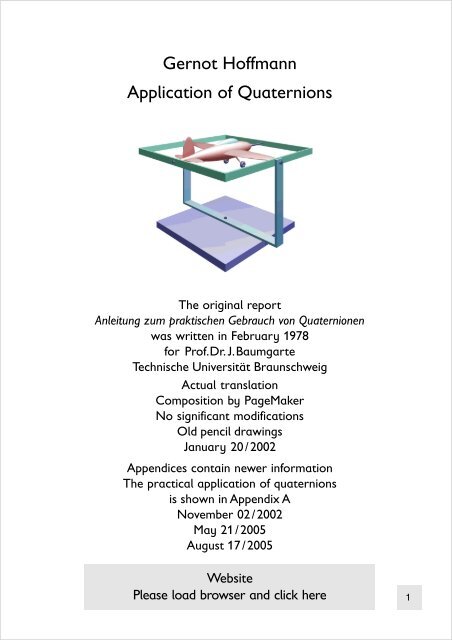



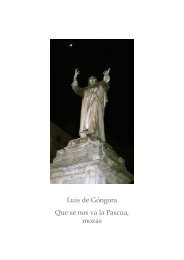
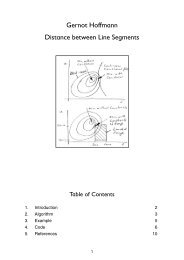
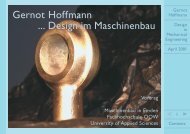
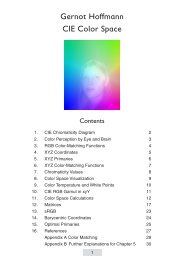
![[PDF] SpieleProgrammierung](https://img.yumpu.com/6860251/1/190x135/pdf-spieleprogrammierung.jpg?quality=85)
